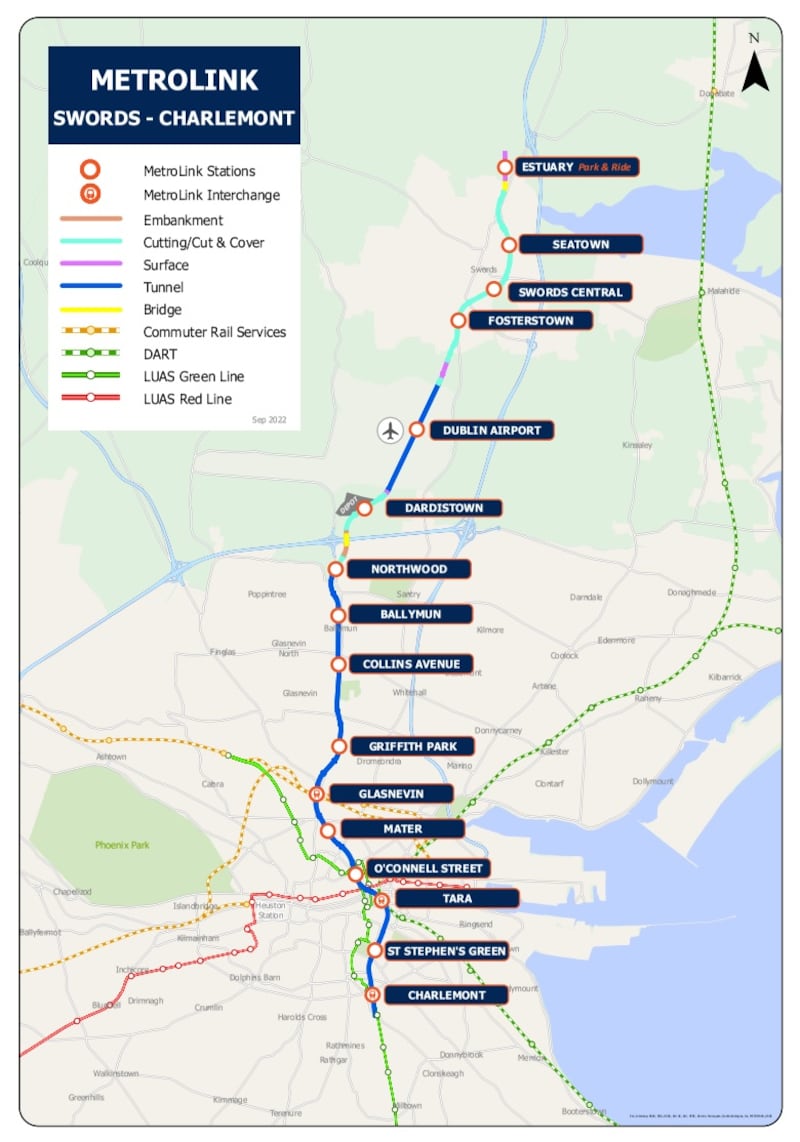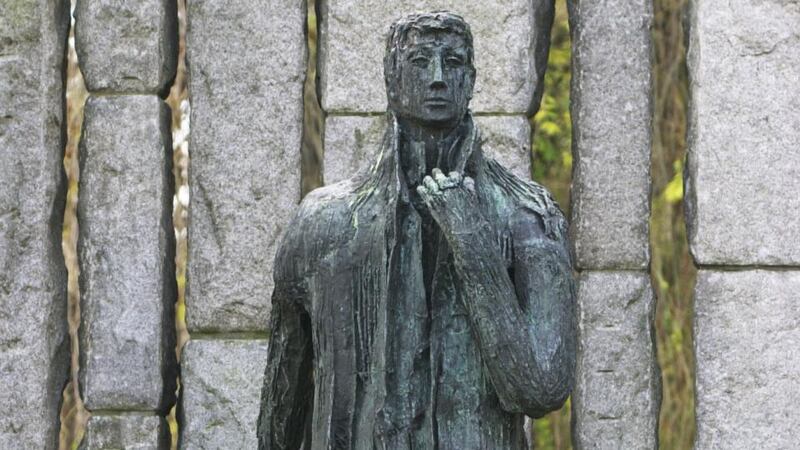MetroLink, its promoters claim, will deliver a “high-capacity, high-frequency, modern and efficient metro railway” with 16 new stations along a route running from Swords to Charlemont on the Grand Canal, linking Dublin Airport, Irish Rail, Dart, Dublin Bus and Luas services to “create a fully integrated public transport network”.
In reality, it is yet another example of the absence of joined-up thinking on transport in Dublin – a stand-alone project that doesn’t make coherent sense on its own and would need to be extended southwards in order to do so. Thus, An Bord Pleanála is faced with making a decision on part of a much larger project without having any idea of where the rest of it would go.
The abrupt termination of MetroLink at Charlemont, in the absence of any firm plan for a future extension, would involve tunnelling deep enough to avoid the Grand Canal and the main sewerage line serving Tallaght that runs alongside it, continuing southwards for 360 metres to create a “turnback facility” for an underground station located beside Dartmouth Square.
This issue was raised by An Bord Pleanála representatives during pre-application consultations with the National Transport Authority (NTA) and Transport Infrastructure Ireland (TII) when they queried “the appropriateness of the selection of Charlemont as the end-point in the light of the decision to omit the Luas Green Line upgrade”. That question has never been satisfactorily answered.
READ MORE
The board’s representatives also queried whether the east side of St Stephen’s Green was the right location for a MetroLink station, “given the distance from Grafton Street and possible future interchange with Dart Underground”. The costly diversion of MetroLink’s alignment to link up with Tara Street station when such an interchange would ultimately be provided by Dart Underground is also questionable.
Another major casualty of MetroLink would be the former Carlton cinema, dating from 1938, which was one of the anchors of O’Connell Street for decades until its closure in 1994
The proposed Tara Street interchange would require demolition of the mid-1990s College Gate apartment block on Townsend Street and Markievicz Leisure Centre, as well as a nearby terrace of social housing adjoining the Loopline railway viaduct. This would be one of the most serious negative impacts of MetroLink in the city centre, as it would result in the loss of more than 80 homes.
Although NTA/TII say the station at Tara Street “has probably involved more studies than any other station on the route”, they declined to avail of the opportunity presented by the clearance of an entire city block bounded by Tara Street, Poolbeg Street, Hawkins Street and Townsend Street to locate the station box beneath a large office complex currently under construction on this site.
Instead, an equally large city block to the east is now slated to be turned into a huge hole in the ground for several years to facilitate construction of the MetroLink station. In addition to College Gate apartments and Markievicz Leisure Centre, this would also require demolition of a substantial office building – Ashford House on Tara Street. Only the offices in which The Irish Times is located would be spared.

‘Profound’ impact
The multi-volume Environmental Impact Assessment Report (EIAR) on the MetroLink project, prepared by Jacobs Idom, acknowledges that part of St Stephen’s Green park “will become a construction site” for the proposed station on its east side, requiring the removal of trees, railings and lamp-posts as well as the Wolfe Tone monument, its array of granite columns and the Famine sculpture behind it.
All of this would have a “profound” impact on the park’s architectural heritage, the EIAR concedes. The main entrance to the MetroLink station would be located within the park, close to its north-eastern corner alongside the “repositioned” Wolfe Tone monument, and there would also be “alterations to the landscaping”. The impact of these permanent changes “will be very significant”.
[ Work set to begin on Liffey Street plaza with trees, benches and bicycle standsOpens in new window ]
Another major casualty of MetroLink would be the former Carlton cinema, dating from 1938, which was one of the anchors of O’Connell Street for decades until its closure in 1994. With seating for 2,000 in its original format before being subdivided into three cinemas in 1976, the entire volume of the Art Deco cinema still survives, including a significant amount of its original fabric.

There is an almost universal view in and around Swords that MetroLink must proceed, irrespective of its negative impacts further down the line as well as its estimated cost
Hammerson plc, the British developers planning the Dublin Central commercial scheme for O’Connell Street/Moore Street, were open to the idea of converting the Carlton into a concert hall or music venue. But that was when the proposed MetroLink station was to be installed in the middle of O’Connell Street, before its location was switched to the west side of the street under the latest NTA/TII plan.

Now, as the EIAR notes, “the Carlton... is to be demolished, except for the facade, as part of the works to construct O’Connell Station”. Nearby neoclassical buildings dating from the reconstruction of O’Connell Street in the 1920s – also protected structures – would be treated similarly, with their facades propped up while the ground behind them is excavated to a depth of 28 metres (92 feet).
Such chopping-and-changing has characterised the metro project since it was first mooted more than 20 years ago. The latest version would also mean writing off a €25 million investment in excavating and installing a metro station box beneath the Mater Hospital’s main block; the plan submitted to An Bord Pleanála would involve digging up the triangular park on Berkeley Road instead.
Nevertheless, there is an almost universal view in and around Swords that MetroLink must proceed, irrespective of its negative impacts further down the line as well as its estimated cost, which ranges from €9.5 billion to as much as €23 billion due to “unknown unknowns”. Fingal County Council is hugely enthusiastic about the project, which it sees as a game-changer to promote development in the area.
Although the thorny issue of whether MetroLink would consume most of the Luas Green Line has been “parked” for another day, there is an overwhelming case to extend it to serve Rathmines – including Cathal Brugha Barracks, now the subject of a Government-sponsored feasibility study for a major housing scheme – and onwards via Harold’s Cross, Terenure and Templeogue to Tallaght.
‘Inadvertent omission’
In November 2021, the NTA announced that it planned to develop new Luas lines serving UCD Belfield and Knocklyon/Rathfarnham to take pressure off the existing Green Line – but only after 2042 – with the aim of removing the need for it to be upgraded to metro standard south of Charlemont. What all of this indicates is that the NTA is making it up as it goes along.
Embarrassingly, the deadline for making observations to An Bord Pleanála on MetroLink’s Railway Order (RO) application had to be extended from November 25th to January 16th due to the “inadvertent omission” of an appendix dealing with the traffic and transportation impacts of the proposed station at St Stephen’s Green. All documentation relating to the project is available at metrolink.ie.
Frank McDonald is a former Environment Editor of The Irish Times.













